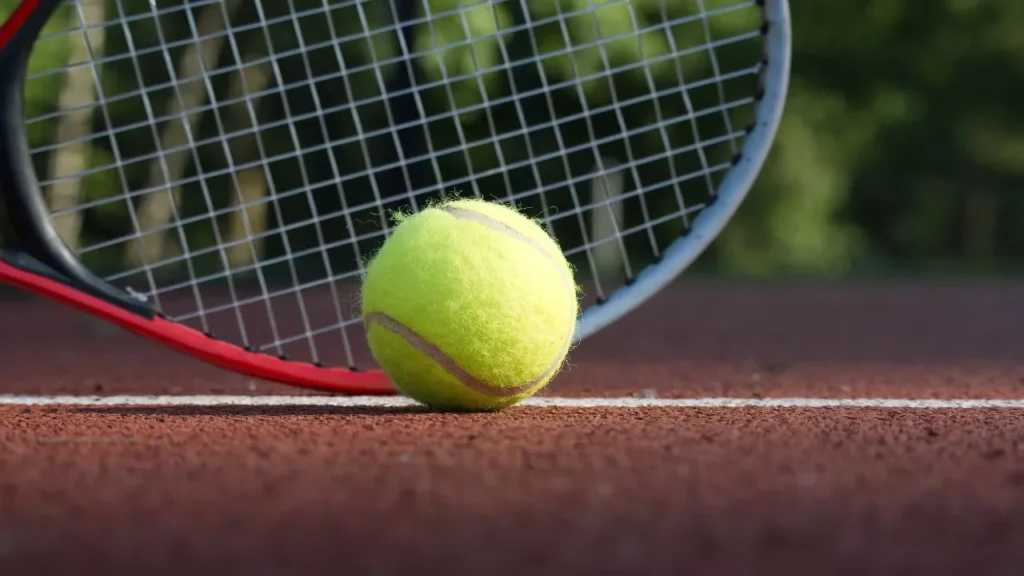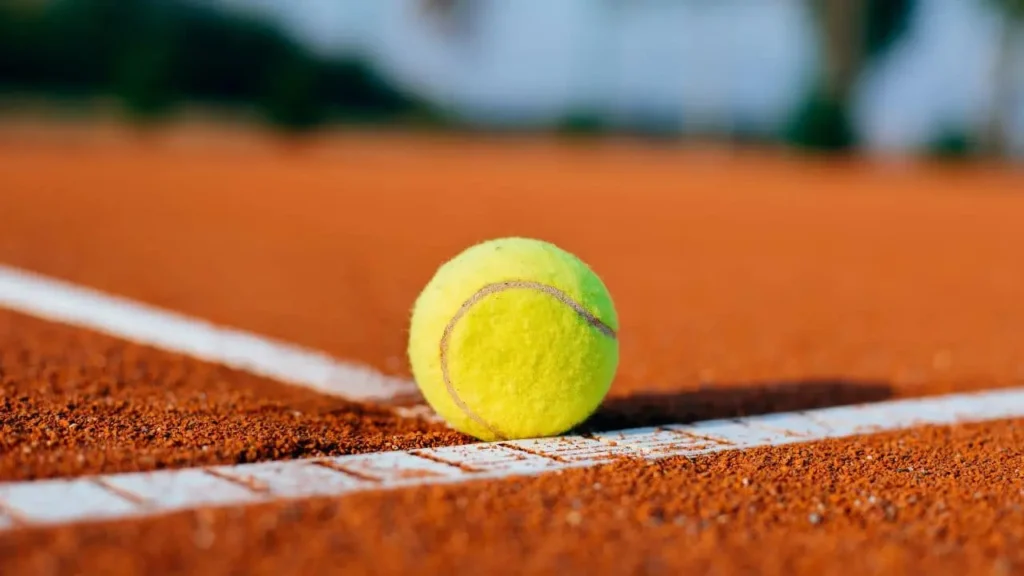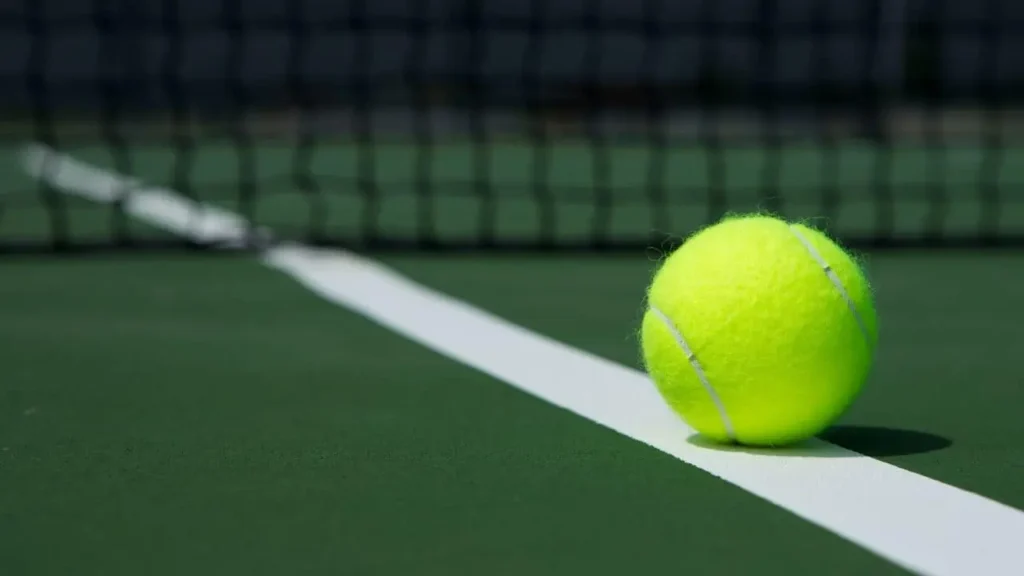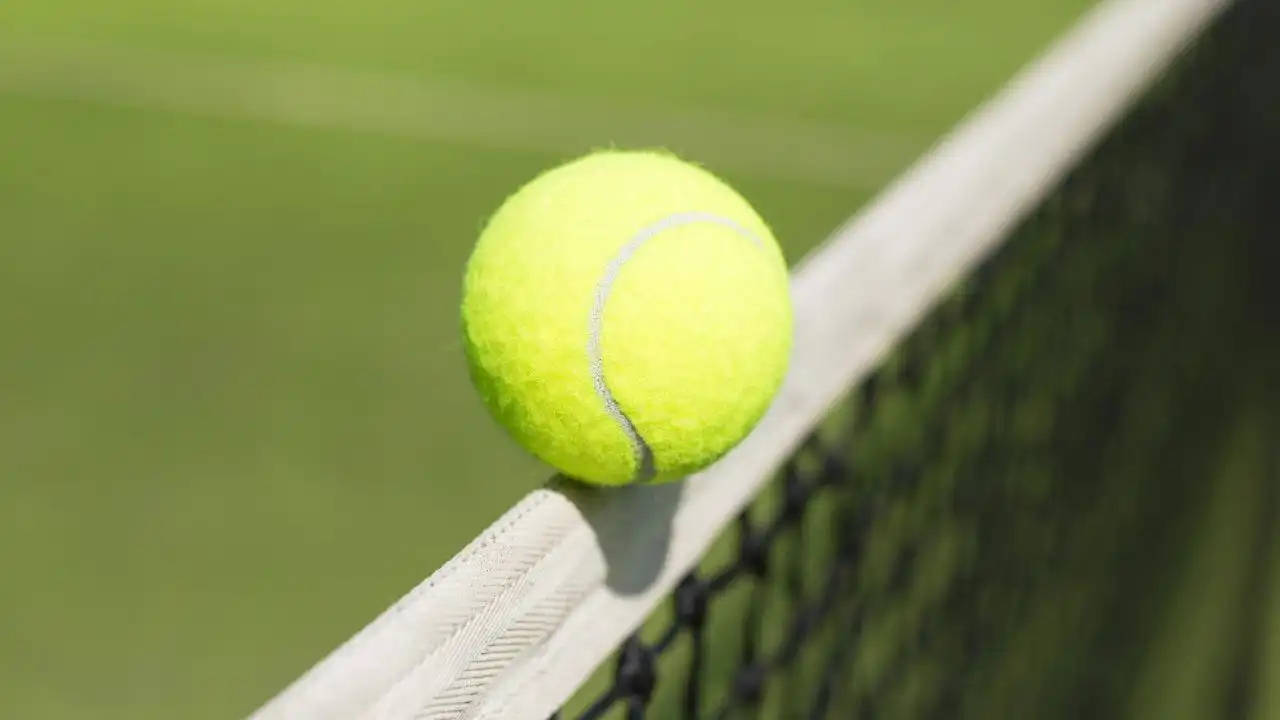Pressureless tennis balls are those balls that don’t have internal air pressure. Instead of having air, these balls are made of a solid rubber core. These are used for practice and training. These balls are most suitable for tennis ball machines and recreational play. They offer a unique alternative to traditional pressurized balls. Their strong rubber shell structure gives these balls a heavier feel. These balls feel firmer due to the solid rubber core. Some players like this firmer feel, while others may find it less forgiving on their arms.
Compared to their peers under pressure, they are slower and don’t bounce as much. Due to the solid rubber core, pressureless balls are heavier than pressurized balls. Pressureless Tennis Balls feel a touch “dead” from the beginning. These balls get more bouncing with time as the rubber inside softens and the felt fabric cover wears off.
The heavier balls will hit your racket more because of their increased weight. Pressureless Tennis Balls are more strong and durable. They produce less spin and need more effort to strike. For general practice, ball machines, and classes, they are perfect. Because they are well constructed from the best materials. They provide hours of play, for such play we offer GAMMA Pressureless Practice Balls. Pressureless types are ideal for ball machines and teaching.
Table of Contents
ToggleFeatures of Pressureless Tennis Balls
Pressureless tennis balls are heavier, harder, and more durable than regular balls. The following situations call for pressureless tennis balls:
Rubber Core
The rubber core of pressureless tennis balls is the solid inner component. This design helps them maintain a consistent bounce and feel throughout their lifespan. The core is made from high-quality rubber, which provides elasticity and resilience. It is composed of a blend of synthetic or natural rubber. This allows the ball to bounce effectively while maintaining its shape over time. It is solid and dense, allowing a reliable bounce and minimal deformation over time.
Best for Recreational play
Pressureless Tennis Balls are the most popular kind of ball. They contain an air-filled core and are well-made of rubber or synthetic rubber. Pressureless Tennis Balls are an excellent option if you only play tennis rarely. Months later, they will still function exactly as they did when you purchased them.
Laeger lifespan
Because they hold their weight, size, and shape over time, these balls are more resilient. They have a far longer shelf life than pressurized balls. Because they don’t lose air over time. They can last longer than traditional pressurized balls. They become an affordable option for regular players.
Easy to control
Due to their softer impact and drill training, pressureless balls are easy to control. The main reason for easy control is their slow speed.This reduced speed can give players more time to react and adjust their positioning They are less forceful, and their bounce and spin make them easier to control. They produce good bounce and control for beginners and students.
Consistent Bounce
Pressureless balls have a lower bounce than pressurized balls when first used. But they maintain this bounce level over time. This makes them a reliable option for training purposes, where consistency is key. Consistent bounce offers many advantages:
- Stable Performance
- Predictable Trajectory
- Improved Training
- Long-Term Use
- Compatibility with Various Surfaces
- Beneficial for Specific Drills
Best for practice
Pressureless balls are more often utilized for practice because of their softness. They aid in the player’s development of stroke accuracy. They are best practice tennis balls since they provide a steady bounce.
Suitable for all courts
Any kind of court surface, including complex, clay, grass, and indoor court use. They are heavier and stiffer since they are solid and do not contain pressurized air. They feature an exterior felt that is more robust and resistant to deterioration.
Best for ball machine
These balls are ideal for ball machines. You can have best practice sessions by using these balls with a ball machine. You will reach an expert level very soon with these balls. Pressureless balls are the best tennis balls for ball machines.
Construction of pressureless tennis ball
For the highest performance, pressureless balls have a different construction than pressurized ones.
Pressureless tennis balls are constructed using a dense rubber compound. It provides durability and resilience. The absence of internal pressure means they don’t lose bounce over time. They can maintain their structure and performance through their material.
They’ll give a few adjustments, including thicker rubber and long-lasting outer felt. While the latter allows them to live longer because their lifespan is far longer. They provide more bounce than pressurized balls.
It’s important to remember that not every pressureless tennis ball has the same feel. Those are well made to use with a ball machine. It will be the best and most robust choice. Rubber substance allows for the distinction of one pressureless ball from another.
Difference between pressureless and pressurized balls
Features | Pressureless Tennis Balls | Pressurized Tennis Balls |
Construction | Solid rubber core | Hollow core filled with pressurized gas |
Bounce | Bounce improves over time as the outer felt wears down | High initial bounce but decreases over time as internal pressure drops |
Durability | Longer-lasting, ideal for extended play | Short lifespan, typically used for a few sessions or matches |
Feel | Heavier and firmer, less responsive than pressurized | Lighter offers a livelier and more responsive feel |
Usage | Best for practice sessions and ball machines | Preferred for official matches and tournaments |
Cost | More cost-effective over time due to durability | More expensive due to frequent replacement needs |
Performance Over Time | Performance improves as felt wears down | Loses bounce and performance quickly after the can is opened |
Surface Compatibility | Suitable for all surfaces, durable for hard courts | It is ideal for all surfaces but wears out faster on hard courts |
Player Preference | Popular with beginners and recreational players | Preferred by advanced and competitive players |
Typical Lifespan | Can last several months to years for recreational play | 1-3 matches before losing optimal bounce |
How Long Do Pressureless Tennis Balls Last
Regular tennis balls may last 2-9 weeks after professional play. But pressureless tennis balls last after one year. They might put in longer than a year at work. The life of a tennis ball depends on the play’s duration. For professional and advanced players, balls may wear out early. But the balls of casual players do not wear out early. Some conditions like safety and care also affect the life period of tennis balls. Best care leads to the long life of tennis balls. Bad conditions may decrease their life.
Advantages of Pressureless Tennis Balls

Pressureless tennis balls offer clear advantages for players seeking the best performance. Their versatility and lasting playability make them very valuable.
- Pressureless tennis balls set themselves apart with their lifespan and resilience. They are generally more durable than pressurized balls. They don’t lose bounce over time because they don’t have air like pressurized balls. They deliver a steady performance that lasts far longer than pressurized competitors.
- Durability. The ball’s structure deteriorates more due to the absence of internal pressure. They are perfect for teaching drills and practice sessions where many balls are used.
- Longevity. Players do not need to replace them with pressurized balls. They keep their bounce and playability for a longer period.
- Unlike pressurized balls, which can lose their bounce over time, pressureless balls maintain a more consistent bounce throughout their lifespan. This stability helps players develop a reliable feel during practice.
- They are perfect for practice sessions, ball machines, and training drills.
- These are cheap and budget-friendly.
- These balls are suitable for indoor courts where moisture can affect other types of balls. They are less sensitive to humidity and environmental conditions.
- Versatile Use. These balls suit players of all skill levels, from beginners to advanced Players. They provide a good balance of performance and durability for various training scenarios.
- Softer Impact. The construction of pressureless balls often results in a softer feel. It reduces the stress on players’ joints and improves comfort during play.
Flexibility and Performance on all Court’s surface
Pressureless tennis balls are unique because they may perform on all courts. Players discover that pressureless balls are versatile and work on all court surfaces.
They offer consistent play on indoor or hard courts or at high altitudes. They perform on different surfaces. So they are a flexible option for players who use various court types. Regardless of how the court surface moves, they respond with reliability. They are less affected by surface friction and environmental fluctuations.
Hard Courts
Pressureless balls perform well on hard courts due to their durability. Hard courts are made from rigid materials like asphalt or concrete. They are covered with acrylic or synthetic material to create a smooth, level playing surface. The top layer is often coated with paint and sand to add texture, affecting grip and ball speed. Since hard courts are abrasive, balls maintain bounce and resist surface damage. As the felt wears down over time, the bounce may improve. These are reliable for extended practice sessions on hard surfaces. The robust structure of hard courts generally allows for a rough surfaces.
Pressureless tennis balls are durable and designed to last longer than pressurized balls. On the rougher surface of hard courts, pressureless balls can maintain shape. They maintain theri bounce for an extended period without losing pressure. This feature makes them a good option for regular practice.
Pressureless balls feel heavier and have a lower bounce initially than pressurized balls. However, as they are used over time, their bounce improves and becomes more consistent. Pressureless balls retain a consistent bounce, making them ideal for long-term use.
Pressureless balls are heavier than pressurized balls, and they may appear less energetic. This may cause shots to feel dead or to come off the racket slowly on a hard court. Players may need to put more effort into generating pace and spin. They don’t pop off the strings as easily as pressurized balls.
The rough surface of a hard court causes the felt to wear out more than on a clay court. Even with the felt wearing down, these balls continue to perform well.
Grass courts
Grass courts are made from a layer of natural grass grown on a firm soil foundation. They are known for their fast speed, lower bounce, and less predictable bounce. Grass courts favor players with solid serves and quick reflexes. The softer ground absorbs some of the impact. The ball can stay lower to the ground, forcing players to adjust their short. Rallies tend to be shorter on grass courts due to fast pace and unpredictable bounce.
Grass courts can soften the bounce of pressureless tennis balls. Grass courts provide a lower bounce compared to other surfaces. So they may not perform as crisply as they do on hard or clay courts. These balls go faster on grass courts because of the reduced friction. They bounce higher than pressured balls, which are best for surfaces. They bounce more than pressurized balls, which can act over grassy terrain.
Clay Courts
Clay courts are often made from crushed shale, stone, or brick. There are two types of clay courts. Red clay and green clay (also known as Har-Tru). The clay surface is relatively soft and malleable compared to hard courts and grass. This causes an underfoot change in the court, impacting player footing and ball movement. Pressureless balls feel heavier on clay courts. It happens due to the accumulation of clay particles on the ball’s felt covering. While they retain their durability, the increased weight may reduce the ball’s speed and bounce. Clay courts slow the ball down, but pressureless balls still maintain their bounce. Compared to hard courts, it could be lower; therefore, the play needs to be adjusted.
Clay courts are infamous for playing slow. The surface absorbs some of the ball’s energy, reducing its speed and making it harder to hit winners. This leads to longer rallies and a more strategic style of play.

Maintenance and Storage Tips
With proper care, these balls have a longer lifespan and reliable performance. Before using them, ensure that they are free from dirt and debris. Use a moist towel to wipe them properly. Playing on clean courts keeps the balls safe. Clay or dirt surfaces can wear down the felt more quickly, so keep them dirt-free.
Pressureless balls are ideal for practice sessions. Regular use can help keep them in good shape. If you have multiple pressureless balls, rotate them during practice to ensure even wear. This can help maintain their performance over time.
Regularly inspect the balls for wear or damage, such as tears or flattening. While pressureless balls are durable, they can still degrade with extensive use. These are best for ball machines because they can withstand repeated impacts.
Disadvantages of Pressureless Tennis Balls
The feel: The hefty feel of a pressureless tennis ball is its primary disadvantage. Though this gets better with time, they tend to feel a touch “dead.” Because of this stiffness, the ball will strike your racket more.
You have to work harder and use greater force with each hit as a result. This raises the possibility of you hurting yourself as well.
Diminished spin reaction: Although the ball’s bounce should get better with continued use. This can still have an impact on the ball’s spin response. Players attempting to improve their swing will not find this acceptable.
When to Use Pressureless Tennis Balls
Coaches often use pressureless balls in practice sessions. Their durability means they can withstand repeated hits without losing performance. Hence these are perfect for drills. These are great for casual players who don’t need high performance.
Many tennis ball machines are designed to work best with pressureless balls. So these are best for ball machines. Players use these balls during warm-ups to get a feel for their strokes.
Top 5 Best Pressureless Tennis Balls
Best pressureless tennis balls have long-lasting durability. Pressureless balls are perfect for practice, drills, and use in ball machines due to their durability. The biggest advantage is that they retain their bounce, even after extensive play. These balls can be used on any type of court surface, like hard, clay, or even grass. A high-quality felt cover ensures a good feel and consistent performance. Premium pressureless balls, such as Tretorn Micro-X and Wilson, come with a durable felt.
This cover provides excellent playability and ensures a comfortable experience similar to regular pressurized balls. Pressureless balls tend to be more cost-effective for players who practice frequently. Many of the top brands, including Penn and Tourna, offer these balls in larger packs. The cover makes them affordable for use in ball machines or for prolonged training.
Some pressureless tennis balls have unique internal micro-cell technology. This technology consists of 700 million air-filled microcells. The cells allow the ball to maintain its bounce indefinitely.
Here is a brief description of the best pressureless tennis balls. Balls from high-quality and top brands are discussed below.

1 . Penn pressureless tennis balls
Penn is a trusted brand in the tennis industry. It is famous for producing cheap and dependable tennis balls. Penn’s pressureless tennis balls are long-lasting, making them popular for practice and leisure play. These are also called the best tennis balls for a ball machine.
With the Penn Pressureless Tennis Balls (12 Balls), you may advance your game. When you’re ready to play, you can use them on the court or at home. They work with tennis ball machines as well. These balls are useful for practice since they are pressure-free. They bounce for a longer period and perform on all types of surfaces.
The coaches and instructors favour them. These pressureless Penn tennis balls are, things considered, priced playthings. They are strong enough to guarantee their resistance to usage. Your game will reach new heights with the aid of the tennis ball pack.
Pros
- Continue to bounce over time.
- long-lasting for prolonged playtime.
- Fit for a range of court surfaces.
- Built to withstand extensive use.
- Penn pressureless balls retain their bounce throughout their lifespan.
- Affordable than some higher-end options.
- Perform well on multiple surfaces, including hard, clay, or grass courts.
- Good for Ball Machines
Cons
- Feel heavier and stiffer
- Less spin potential
- Primarily designed for practice, not competitive match.
2. Tretorn Micro X pressureless balls
The Tretorn Micro-X pressureless tennis balls are the finest in the pressureless class. They are the best option for tennis ball machines. Tretorn Micro-X balls are often designed with superior eras to offer sturdiness and consistent playability. The first high-performance microcell tennis ball, Micro X, features unique technology. It is propelled by 700 million air-filled microcells for enhanced playability. Thanks to Micro X technology, ball machines can throw balls better.
The premium felt offers superior durability and maintains its integrity. The felt ensures a smooth, controlled feel comparable to pressurized balls.
Because of their adaptability, Micro X balls can be used on clay, grass, and hard courts because of their adaptability. These balls are perfect for all court surfaces, including lower bouncing surfaces. Suitable for play in colder climates and at high altitudes because of construction. Tretorn Micro-X has micro-mobile technology to supply a natural experience and jump.
Pros
- Extended play is best guaranteed by our microcellular technology.
- Steady bounce without sacrificing effectiveness.
- Outstanding resilience and impact feel.
- Incredibly durable, lasting much longer.
- Performance on multiple surfaces.
- The premium felt cover for durability and consistency.
Cons
- They are more expensive than other pressureless tennis balls.
- Heavier, firmer feel compared to regular pressurized balls.
- Not Ideal for competitive match play.
3. Tourna Pressureless Tennis Balls
Tourna Pressureless Tennis Balls are a popular and powerful alternative. They are known for their solid overall performance and sturdiness. Tourna consistent bounce tennis balls never leaps. Even if you don’t use them, regular tennis balls become flatter with time. For the duration of their lives, these balls will always bounce similarly. The Tourna Pressureless tennis balls have a long-lasting feel. They are perfect for playing with your pets or using tennis ball machines.
Tennis balls from Tourna are the proper size and bounce to a standard height. Compared to a standard ball, many pressureless balls are smaller. Tourna Pressureless tennis balls allow you to practice and play with confidence. These balls are often used for education sessions and leisure play. They are the favorite of many coaches and players for their ability to maintain leap and playability.
Pros
- Offer long-term durability without losing bounce.
- Affordable compared to other premium options.
- These balls hold well on tough court surfaces, such as asphalt or concrete.
- Excellent for casual matches, practice sessions, and warm-up drills.
Cons
- Tourna’s version has a heavier and firmer feel.
- Not suitable for competitive matches.
- The felt on these balls may wear down with heavy use.
4. GAMMA pressureless tennis balls
GAMMA pressureless tennis balls are built with a durable rubber core and felt. They can withstand heavy use without losing bounce. These beginner tennis balls are for smaller players. They are an excellent option for teaching adults or beginners. They are ideal for long practice sessions across various court surfaces. These balls are perfect for ball machines and large practice sessions.
TWO-TONED SURFACE. These tennis balls are 15% larger than regular tennis balls. They stand out from the crowd thanks to their vivid yellow and red felt surface. Players can practice hitting and returning slice and topspin strokes with their help.
FITTED FOR 36-IN CHESTS. These practice tennis balls are ideal for teaching youth. because of their slower and lower bounce. Which are best designed for players starting on 36-foot courts.
Pros
- Durable and long-lasting, perfect for extended use.
- Consistent bounce throughout the lifespan.
- Affordable, especially when bought in bulk.
- Versatile on different surfaces.
- Ideal for ball machines and repetitive practice.
Cons
- Heavier, firmer feel compared to pressurized balls.
- Not suitable for competitive match play.
- Felt may wear out over time with heavy use.
5. Wilson Pressureless tennis balls
Wilson is a well-known name in tennis. It offers high-quality pressureless tennis balls designed to withstand the harshness of constant play. These pressureless tennis balls are built for durability and retain their bounce. The felt cover offers a comfortable feel on both hard and clay courts. It is also ideal for ball machines or regular practice. Wilson balls are a popular choice among recreational players and coaches for practice sessions.
Wilson’s pressureless balls maintain their bounce indefinitely. This feature makes them useful for players who want balls for consistent practice. They are cost-effective and don’t lose air or go flat. You can use them because you would not replace tennis balls as often. They are often sold in bulk quantities. Hence these are ideal for tennis clubs, instructors, or players who need a large quantity.
Wilson’s balls feel slightly heavier and firmer compared to pressurized balls. This can lead to a stiffer hit, which might cause some adjustment problems during hitting. Wilson pressureless tennis balls perform well across all court surfaces.
Pros
- Don’t lose air or bounce, durrable and long lasting.
- Perfect for long training drills.
- Perform well on a variety of court surfaces, from clay to hard courts.
- A good choice for outdoor use.
- Suitable for players or coaches who rely on ball machines for repetitive drills.
Cons
- Heavier and firmer feel.
- Best for practice, not for competitive matches.
Conclusion
Pressureless Tennis Balls keep their bounce and aerodynamic qualities for longer periods. Their versatility and lasting playability make them very valuable. Due to their softness, pressureless tennis balls are for practice. They’ll make some adjustments, including thicker rubber and more robust, long-lasting felt. In contrast, the latter allows them to live longer because their lifespan is far longer.
At the end of this blog post, you can differentiate these balls. Tourna, Tretorn, and Penn are the top brands that can give high performance. The bounce of Tourna pressureless balls never leaps. The best option for tennis ball machines is globally Tretorn Micro-X balls. When you check pressureless vs pressurized tennis balls you will choose pressureless.
FAQs
Learn how pressureless balls differ from regular balls, and why they’re perfect for practice. Read all these queries in the Frequently Asked Questions, mentioned below.
Pressureless balls are cost-effective since they are less likely to lose bounce. Compared to their rivals under pressure, they outlast them and deliver reliable performance.T
Pressureless tennis balls are available from several brands. Tretorn and Gamma are well-liked brands that provide robust, prolonged practice sessions.
Because pressureless tennis balls have differing performance characteristics, they are for practice. They are suitable for informal matches if longevity is more important.
Low-compression balls should bounce lower and move more slowly than standard balls. They are ideal for beginners and children too.
Compared to pressurized, pressureless balls feel stiffer and have less initial bounce. Over time, pressureless balls may get buoyant as their rubber shell softens with wear. while pressurized balls lose their bounce because of air leaks.
pressureless balls use the properties of their rubber core and outer felt to deliver a consistent bounce. Their bounce comes from the elasticity of the rubber itself. This solid core gives the ball its bounce and durability.

